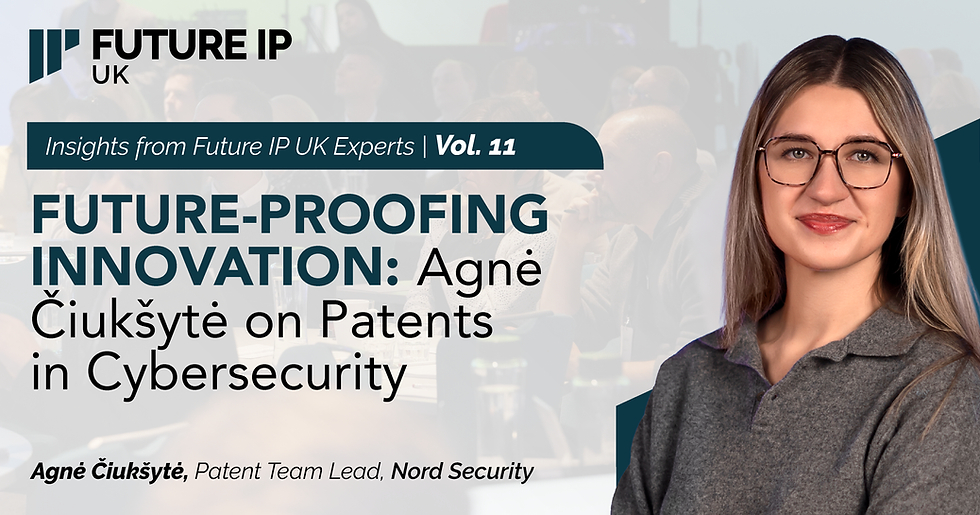Insights from Future IP UK Experts Vol.11: Future-Proofing Innovation: Agnė Čiukšytė on Patents in Cybersecurity
- Min Nguyen
- Sep 22
- 7 min read

With technology advancing at a rapid pace and threats evolving daily, protecting innovation requires both foresight and adaptability.
At Future IP UK, we are proud to welcome Agnė Čiukšytė, Patent Team Lead at Nord Security - the company behind global products such as NordVPN, NordPass, NordLayer, NordLocker, Saily e-SIM, NordStellar, and NordProtect., to the keynote stage.
With deep expertise in building resilient, future-ready patent strategies, Agnė will share her perspective in her Keynote session “IP and Business Strategy: Communicating the Value of Your IP Portfolio.”
In this exclusive interview, Agnė will share her perspective on how cybersecurity businesses can leverage IP strategically, the hurdles of cross-border protection, and the trends shaping the next chapter of digital innovation. The world of intellectual property and innovation management is evolving rapidly, demanding leaders who can combine technical expertise with strategic vision.
Given Nord Security’s focus on digital security and privacy, what unique IP challenges do you encounter in protecting innovation in such a rapidly evolving technological landscape?
In cybersecurity, time is always against you. An idea that seems groundbreaking today can quickly be surpassed by new threats or technologies. By the time a patent is granted, the situation may have changed significantly. That’s why, when we assess ideas, we don’t simply ask, “Is this new?” We ask, “Will this still matter three to five years from now?” This approach encourages us to think strategically and to build a portfolio that reflects not only the current state of the industry but also its future direction.
Another challenge arises from the very nature of what we create. Much of our work involves software - encryption algorithms, secure communication protocols, threat detection methods. These concepts are inherently abstract, and the boundary between a true technical invention and what might be perceived as a “mere idea” can be unclear. To protect these innovations, we must carefully communicate the story of the technology. We should highlight not just the concept but also the specific problem it addresses and the technical solution it provides.
In many ways, protecting intellectual property in digital security feels like constructing a bridge while the river below is continually changing. The threats evolve, the tools change, and our innovations must adapt as well. The real challenge - and the real reward - lies in ensuring our protection methods keep up so that our users stay safe in a constantly shifting landscape.
As the Patent Lead at Nord Security, what are your key priorities and strategies for building and maintaining a robust patent portfolio in a competitive global market?
For me, everything starts with the business. If we don’t understand where the company is headed, we can’t build a patent portfolio that truly supports it. My first priority is always to stay closely connected to our business goals. This means identifying the technologies that are essential to who we are; the innovations that matter to our users and give us an advantage in the market. Once these are clear, the rest of the priorities fall into place.
After that, it’s about being proactive instead of reactive. A strong portfolio isn’t just about filing more patents; it’s about filing the right ones. We regularly review and improve what we have, ensuring that each patent still serves its purpose, whether that’s protecting a product, supporting a partnership, or positioning us competitively. Sometimes this means cutting what we don’t need, and sometimes it means investing more in our key patents.
In a fast-moving global market, maintaining a strong portfolio is less about quantity and more about quality and relevance. Our goal is to keep it dynamic; it must evolve with the business, so it always reflects where we are today and where we’re headed tomorrow.
With the increasing focus on cross-border IP enforcement, what are some of the biggest hurdles and opportunities for a company like Nord Security in protecting its IP internationally?
Protecting IP across borders is never simple. Each country has its own rules and systems. What works in one place might not work the same way in another. Pursuing protection internationally can be expensive and time-consuming. This is especially true when you’re trying to coordinate across different regions and gather the right information to support your case.
These challenges also present opportunities. They encourage us to consider where our innovations matter most. Instead of trying to cover everything everywhere, we can focus our efforts on the markets that are strategically important for our business and our users.
It’s about finding the right balance. We need to invest wisely in protecting what matters while staying flexible enough to adjust as global conditions change. For us, this approach turns cross-border complexity into a chance to refine our strategy and strengthen our innovation story worldwide.
Beyond patents, what other forms of intellectual property, such as trademarks or trade secrets, are particularly crucial for Nord Security’s overall IP strategy, and why?
While patents are central to my work at Nord Security, they are just one part of the broader picture. For a technology company like ours, patents are essential because they protect our innovations, including functional breakthroughs, technical solutions, and the ideas that drive our products. They safeguard what we build today and help shape our future in a competitive market.
However, patents do not stand alone. They are most effective when combined with other types of intellectual property. Copyrights, for instance, protect the software code and user interfaces that bring our patented technologies to life. Trade secrets allow us to keep certain algorithms and processes confidential, giving us an advantage in areas where disclosing information through patents may not be ideal. Trademarks ensure that when users see “Nord Security”, they instantly connect this name with trust and security.
Together, these layers create a strong protection.
What emerging IP trends, particularly those related to technology and digital content, do you believe will have the most significant impact on companies like Nord Security in the next 1-3 years?
Over the next few years, I believe AI will continue to be the most disruptive force in intellectual property. At the same time, blockchain, NFTs, and the metaverse are creating completely new areas for digital ownership and authenticity. They offer exciting opportunities but also new risks. We need to protect virtual assets and digital identities while extending traditional IP protections into areas that didn’t exist a few years ago.
For Nord Security, this changing landscape isn’t just a legal or technical matter - it’s a call to respond. Our success will depend on being flexible, protecting our key innovations, and viewing these trends as opportunities to lead instead of threats.
What message or key takeaway do you hope attendees will gain from your session at the Future IP UK event?
The key message I want attendees to understand is that the role of an IP professional is changing. In the tech sector, we’re no longer just seen as disruptors who slow things down or gatekeepers who say yes or no. Instead, our real value comes from being connectors and enablers - people who bridge innovation, business, and strategy. With technologies evolving quickly and IP becoming more global and complex, the best strategies aren’t built in isolation. They’re created by working closely with product teams, business leaders, and even external partners. This ensures that IP is not just a legal asset, but also a driver of growth and collaboration.
If there’s one takeaway, it’s that IP can and should be part of the innovation story. It should not stand on the sidelines, but actively help shape it.
From your perspective, how can businesses best prepare their IP strategies to navigate the uncertainties and complexities of the intellectual property landscape in 2025 and beyond?
Looking ahead to 2025 and beyond, businesses that will succeed are those that view IP as a strategic tool. This tool shapes decisions about growth, market entry, and competitive positioning. It’s not just about filing for the sake of it, but about using IP to steer the business toward long-term opportunities.
This focus means protecting the innovations that truly matter for growth, market leadership, and differentiation. It involves making thoughtful decisions about where to invest resources, which markets to enter, and how to position ourselves against competitors. IP should guide these choices, not just react to them.
To make this happen, IP must be part of the conversation early and frequently—during R&D, business planning, and market expansion decisions. It demands clear communication, collaboration among different teams, and the ability to adjust as technologies, competitors, and regulations evolve.
At its best, IP offers more than just protection. It drives innovation, helps reduce risks, and creates new opportunities. When it’s at the core of strategy, it transforms from a business cost into a true engine of long-term success.
What advice would you offer to young professionals looking to build a career in intellectual property, especially in the technology sector?
If I had to give one piece of advice, it would be: stay curious. Curiosity opens doors. It helps you learn faster, connect with people who can teach you, and identify opportunities you might have otherwise missed. In intellectual property, especially in technology, things move quickly. A curious mindset is the best tool you can have.
Don’t be afraid to ask questions and admit what you don’t know. Some of the best conversations I’ve had began with simply asking, “Can you explain this to me?” You’ll be surprised at how willing people are to share their knowledge.
Finally, try to view IP not just as a legal framework but as part of the bigger picture. Consider how it connects to technology, business, and people. If you combine curiosity with a willingness to learn from others and an openness to see the broader story, you’ll build not just a career but a very rewarding one.
Join Agnė Čiukšytė at Future IP UK as she shares her expertise on building resilient patent strategies and aligning IP with broader business objectives.
Secure your spot today to join the conversation on building smarter, more agile IP strategies for the future.
Written by Min Nguyen, Content Executive





Comments